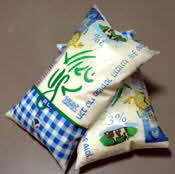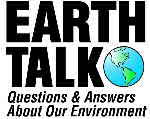MILK BAGSEarthTalk
From the Editors of E/The Environmental Magazine Dear EarthTalk: I've been hearing about the popularity of milk sold in bags (as opposed to plastic or cardboard cartons) in India, Europe and Canada. What are the environmental advantages to milk in bags, and do you think it will catch on in the U.S.? And what other options are out there for milk drinkers trying to be green? -- Paul Howe, San Francisco, CA It’s true that plastic milk bags—not the cartons or jugs we are used to here in the U.S.—are de rigueur in many parts of Europe, Latin America and India and are catching on fast in Canada, South Africa, China and elsewhere. They typically hold a liter of milk and are sold in three-packs. Most people snip off a corner of the milk bag and keep it upright in a pitcher in the fridge. When the last drop has been used up, the bags, which are made out of easily recycled high-density polyethylene, can be rinsed out and tossed in with other recycling. Best of all, they use 75 percent less plastic than similar capacity plastic milk jugs. 
The fact that milk bags are easy to recycle and use much less plastic (and as such are inexpensive) may be a big part of the reason for their popularity all over the world. They are more popular than ever in Great Britain today amid concerns that plastic milk jugs there are not being recycled at adequate levels. At least two of the UK’s largest grocery chains have switched over to milk bags in the last two years. Of course, detractors point out that milk bags are not as sturdy as plastic jugs—they can puncture or burst if too much pressure is applied. Also, they do not stand upright like harder containers and cannot be sealed once snipped open—and are thus more prone to spilling. Perhaps for these reasons, milk bags are losing market share in many regions of the former Soviet bloc, where they were for years the most common packaging for milk. Some analysts cite the so-called “lower shelf appeal” of milk bags as the reason, which might have something to do with why U.S. supermarkets haven’t yet been eager to embrace them.
Of course, paper/cardboard (half-gallon) milk containers are also relatively friendly to the environment, especially if the empty boxes are worked into compost either at the residential or municipal level, or rinsed well and recycled. They tend to be more expensive than plastic jugs, though, as they cost more to make. Several companies are working on ways to employ recycled paper and cardboard into larger milk jugs while keeping costs comparable to inexpensive plastic jugs. And while most of us no longer employ milk delivery services to our homes, the glass bottles that they use (yes they still exist!)—and take back for reuse—may be the ultimate in eco-friendly milk storage, although driving the milk around and washing all the glass bottles are not the most eco-friendly activities.
Perhaps the modern-day version of the milkman is the herd share, whereby regular folks contribute annually or monthly to a local dairy farm in exchange for a gallon of milk fresh from the cow every week. Many of the herd shares offered these days feature organic milk from grass-fed cows, giving eco-conscious consumers a way to help keep small farmers alive while enjoying milk they know is safe and healthy. To find a herd share to join in your area, check out the Local Chapters website page of the Weston A. Price Foundation, a charity that works to disseminate the research of whole foods nutrition pioneer Dr. Weston Price. 
CONTACTS: Weston A. Price Foundation, www.westonaprice.org; Farm-to-Consumer Legal Defense Fund, www.ftcldf.org.
SEND YOUR ENVIRONMENTAL QUESTIONS TO: EarthTalk®, c/o E – The Environmental Magazine, P.O. Box 5098, Westport, CT 06881; earthtalk@emagazine.com . E is a nonprofit publication. Subscribe: www.emagazine.com/subscribe; Request a Free Trial Issue: www.emagazine.com/trial.
| 